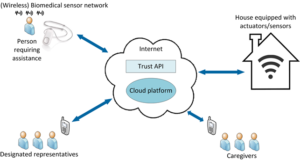There is a need to provide timely assistance to people who run an increased risk of accidents, malfunctioning, diseases, strokes, etc., in particular elderly people, recovering or disabled people and possibly children. The goal is to monitor these people (target group) and their behaviour in order to reduce risks, to avoid accidents, to give preventive warnings, to initiate corrective measures or to ask for assistance, e.g., from nearby “trusted” caregivers.
By applying advanced wireless sensor technology, it becomes possible to monitor the health and wellbeing of these frail people, determine their location, and possibly what they are doing. Because a designated representative of such a person, e.g. a family member or a neighbour, is not always available or nearby to provide assistance, there is a need for a solution that allows other qualified and trusted caregivers to take over this role when this is most appropriate. This also includes remote control over specific home functions by a person with a high trust-level, again, typically a close family member, which may assist the person in need to perform certain tasks, and the ability to check to which extent nearby caregivers have access to the personal and health data of the person in need and to which extent they are allowed to help them (e.g. access to home, access to drugs).
To improve the quality of assisted living and community care of frail people, we identify the following objectives:
The objectives of SCOTT in terms of measureable indicators are:
The objectives of SCOTT in terms of measureable indicators are:

